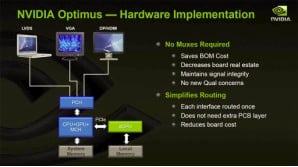NVIDIA Optimus Mobile Technology Preview
NVIDIA Optimus Mobile Technology
 A few years ago and again only recently, a select few notebooks hit the scene with "switchable graphics". That is to say, these notebooks are able to manually switch between low-power integrated graphics solutions in the notebook chipset, to more powerful, and higher-performing discrete graphics processors. To enthusiasts, power users, or even somewhat tech savvy consumers, switchable graphics seemed like a no compromise solution. The IGP could be used to conserve battery life when multimedia performance wasn't necessary, while the discrete GPU was available for more demanding applications.
A few years ago and again only recently, a select few notebooks hit the scene with "switchable graphics". That is to say, these notebooks are able to manually switch between low-power integrated graphics solutions in the notebook chipset, to more powerful, and higher-performing discrete graphics processors. To enthusiasts, power users, or even somewhat tech savvy consumers, switchable graphics seemed like a no compromise solution. The IGP could be used to conserve battery life when multimedia performance wasn't necessary, while the discrete GPU was available for more demanding applications.
In practice, however, notebooks with switchable graphics were somewhat cumbersome to use in the real world. In many cases, a physical switch had to be flipped, applications had to be closed, and the system had to be restarted. And to switch back, the process had to be repeated over again. Not to mention, the need to incorporate the switches and the other necessary hardware to support having a pair of GPUs connected to the same set of outputs, added complexity to the notebook's designs, that ODMs had to contend with. Switchable graphics, while great in theory, didn't always provide a great user experience or at least the implementation could have been much cleaner.
Ideally, switchable graphics would be seamless. Launch an application that doesn't require significant GPU resources, and the IGP gets used. Fire up a game though, and the discrete GPU kicks in. Up to this point, a scenario like this simply wasn't available, but NVIDIA aims to change that with the release of their Optimus technology. About a month ago, when NVIDIA first hinted at the existence of Optimus, we posted some information about NVIDIA's teaser right here.
That teaser didn't exactly spell out what Optimus was all about, so we speculated a bit about what NVIDIA had in store. While we were partially correct in our assumption that Optiumus-enabled GPUs are capable of shutting down parts of the GPU while not in use, we didn't realize exactly how much could be disabled. In reality, Optimus turned out to be much more that we thought.


Left: NVIDIA's Optimus Graphics Solution - Right: Legacy Design Approach






